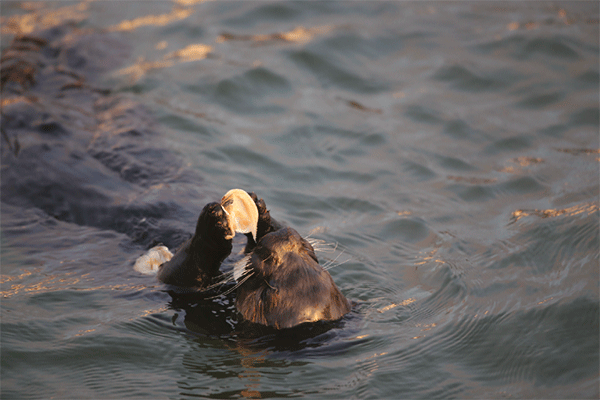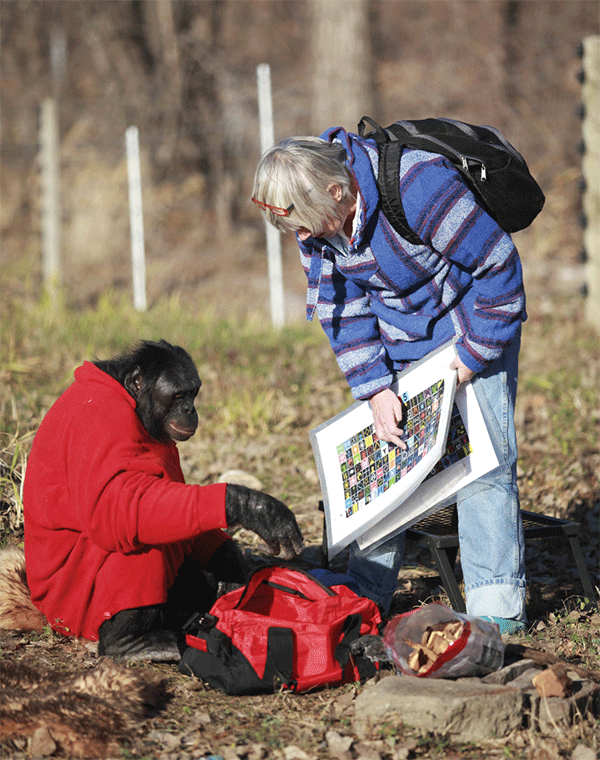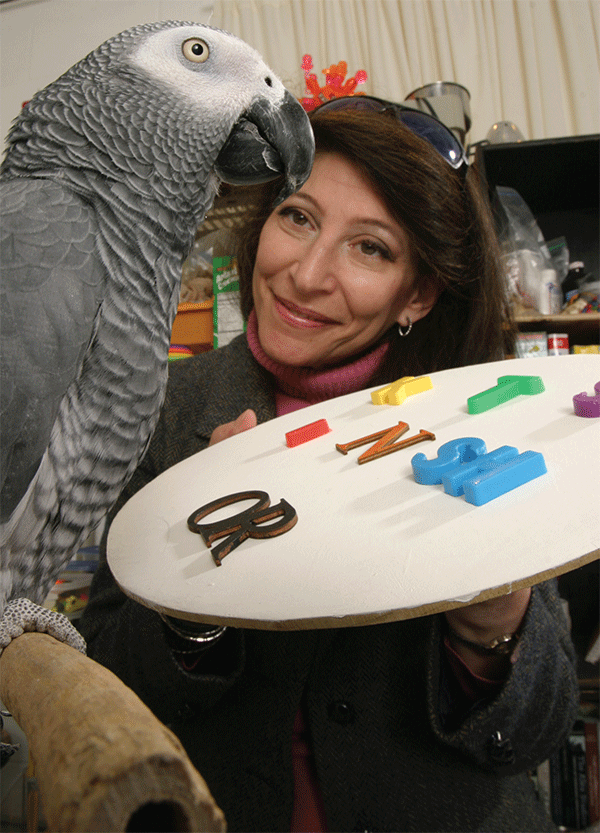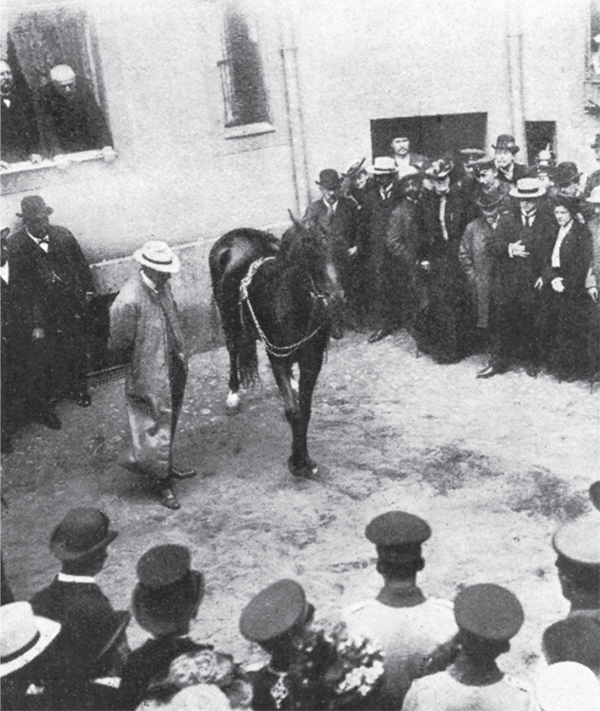9.5
Animal Minds
A green heron swipes some bread from a picnicker's table and scatters the crumbs on a nearby stream. When a minnow rises to the bait, the heron strikes, swallowing its prey before you can say “dinnertime.” A sea otter, floating calmly on its back, bangs a mussel shell against a stone that is resting on its stomach. When the shell cracks apart, the otter devours the tasty morsel inside, tucks the stone under its flipper, and dives for another shell, which it will open in the same way. Incidents such as these and scores of others have convinced some biologists, psychologists, and ethologists that we are not the only animals with cognitive abilities—that “dumb beasts” are not so dumb after all. But how smart are they?

How smart is this otter?
Animal Intelligence
In the 1920s, Wolfgang Köhler (1925) put chimpanzees in situations in which some tempting bananas were just out of reach and watched to see what the apes would do. Most did nothing, but a few turned out to be quite clever. If the bananas were outside the cage, the chimp might pull them in with a stick. If they were hanging overhead, and there were boxes in the cage, the chimp might pile up the boxes and climb on top of them to reach the fruit. Often the solution came after the chimp had been sitting quietly for a while. It appeared as though the animal had been thinking about the problem and was struck by a sudden insight.
Learning theorists felt that this seemingly impressive behavior could be accounted for perfectly well by the standard principles of operant learning, without resorting to mental explanations. Because of their influence, for years, any scientist who claimed that animals could think was likely to be ignored or laughed at. Today, however, the study of animal intelligence is booming, especially in the interdisciplinary field of cognitive ethology. (Ethology is the study of animal behavior, especially in natural environments.) Cognitive ethologists argue that some animals can anticipate future events, make plans, and coordinate their activities with those of their comrades (Griffin, 2001).
When we think about animal intelligence, we must be careful because even complex behavior that appears to be purposeful might be genetically prewired and automatic, instead of requiring cognition (Wynne, 2004). The assassin bug of South America catches termites by gluing nest material on its back as camouflage, but it is hard to imagine how the bug's tiny dab of brain tissue could enable it to plan this strategy consciously. Yet explanations of animal behavior that leave out any sort of consciousness at all and that attribute animals' actions entirely to instinct do not seem to account for some of the amazing things that animals can do. Like the otter that uses a stone to crack mussel shells, many animals use objects in the natural environment as rudimentary tools, and in some nonhuman primates, the behavior is learned.
Thus, chimpanzee mothers occasionally show their young how to use stones to open hard nuts (Boesch, 1991). Orangutans in one particular Sumatran swamp have learned to use sticks as tools, held in their mouths, to pry insects from holes in tree trunks and to get seeds out of cracks in a bulblike fruit, whereas nearby groups of orangutans use only brute force to get to the delicacies (van Schaik, 2006). Even some nonprimates may have the capacity to learn to use tools, although the evidence remains controversial among ethologists. Female bottlenose dolphins off the coast of Australia attach sea sponges to their beaks while hunting for food, which protects them from sharp coral and stinging stonefish, and they seem to have acquired this unusual skill from their mothers (Krützen et al., 2005). Is this yet another case of mothers telling their daughters what to wear?
In the laboratory, nonhuman primates have accomplished even more surprising things; for example, chimpanzees have demonstrated that they have a rudimentary sense of number. In one study, chimps compared two pairs of food wells containing chocolate chips. One pair might contain, say, five chips and three chips, the other four chips and three chips. Allowed to choose which pair they wanted, the chimps almost always chose the one with the higher combined total, showing some sort of summing ability (Rumbaugh, Savage-Rumbaugh, & Pate, 1988). Chimpanzees can even remember over a period of 20 minutes which of two containers holds more bananas (e.g., five versus eight, or six versus 10), after watching the bananas being placed one at a time into the containers. In fact, they do as well as young children on this task (Beran & Beran, 2004; Parrish, Evans, & Beran, 2014).
One of the most controversial questions about animal cognition is whether any animals besides human beings have a theory of mind, a system of beliefs about the way one's own mind and the minds of others work, and an understanding of how thoughts and feelings affect behavior. A theory of mind enables you to draw conclusions about the intentions, feelings, and beliefs of others; empathize with others (“What would I experience if I were in the other person's position?”); deceive others; recognize when someone else is lying; recognize yourself in a mirror; and know when others can or cannot see you. In human beings, a theory of mind starts to develop in the second year and is clearly present by about age 3 or 4.
Some researchers believe that the great apes (chimpanzees, gorillas, and orangutans), dolphins, and elephants have certain abilities that reflect a theory of mind (de Waal, 2001; Plotnik, de Waal, & Reiss, 2006; Suddendorf & Whiten, 2001). When looking in a mirror, these animals may try to find marks on their bodies that are not directly visible, suggesting self-recognition, or at least bodily awareness. In addition, chimpanzees console other chimps who are in distress, use deceptive tactics when competing for food, and point to draw attention to objects, suggesting that they are able to grasp what is going on in another chimp's mind. In the wild, when one male African chimp makes an exaggerated scratching movement on part of its body during social grooming—say, on the forehead—a comrade will then groom the indicated spot, even if he was already grooming some other spot (Pika & Mitani, 2006). Chimps and even monkeys may also be capable of some metacognition, the ability to understand and monitor their own cognitive processes. When they are tested on a new task, they will sometimes avoid difficult trials in which they are likely to be wrong. And they will press an icon on a touch screen to request “hints” provided by their human observers when they are unsure of the correct response, even when seeking a hint means getting a lesser reward for a correct answer (Kornell, 2009). These findings suggest that the animals know what they know and don't know.
Sultan the Clever Chimp

Animals and Language
A primary ingredient of human cognition is language, the ability to combine elements that are themselves meaningless into an infinite number of utterances that convey meaning. Do animals have anything comparable? Many people have wished they could ask their pet what it's like to be a dog, or a cat, or a horse. If only animals could speak!
To qualify as a language, a communication system must use combinations of sounds, gestures, or symbols that are meaningful, not random. It must permit displacement, communication about objects and events that are not present here and now but rather are displaced in time or space. And it must have a grammar (syntax) that permits productivity, the ability to produce and comprehend an infinite number of new utterances. By these criteria, no nonhuman species has its own language. Animals do communicate, of course, using gestures, body postures, facial expressions, vocalizations, and odors. Some of these signals have highly specific meanings: Vervet monkeys seem to have separate calls to warn about leopards versus eagles versus snakes (Cheney & Seyfarth, 1985). But vervets cannot combine these sounds to produce entirely novel utterances, as in “Look out, Harry, that eagle-eyed leopard is a real snake-in-the-grass.”
Perhaps, however, some animals could acquire language if they got a little help from their human friends. Because the vocal tract of an ape does not permit speech, most investigators have used innovative approaches that rely on gestures or visual symbols. In one project, chimpanzees learned to use as words geometric plastic shapes arranged on a magnetic board (Premack & Premack, 1983). In another, they learned to punch symbols on a keyboard monitored by a computer (Rumbaugh, 1977). In yet another, they learned hundreds of signs in American Sign Language (Fouts & Rigby, 1977; Gardner & Gardner, 1969).
Animals in these studies learned to follow instructions, answer questions, and make requests. They even seemed to use their newfound skills to apologize for being disobedient, scold their trainers, and talk to themselves. Koko, a lowland gorilla, reportedly used signs to say that she felt happy or sad, to refer to past and future events, to mourn for her dead pet kitten, and to lie when she did something naughty (Patterson & Linden, 1981). Most important, the animals combined individual signs or symbols into longer utterances that they had never seen before.
Unfortunately, in their desire to talk to the animals and their affection for their primate friends, some early researchers overinterpreted the animals' utterances, reading all sorts of meanings and intentions into a single sign or symbol, ignoring scrambled word order (“banana eat me”) and unwittingly giving nonverbal cues that might enable the apes to respond correctly. But over the past few decades, as researchers have improved their techniques, they have discovered that with careful training, chimps can indeed acquire some aspects of language, including the ability to use symbols to refer to objects. Some animals have also used signs spontaneously to converse with each other, suggesting that they are not merely imitating or trying to get a reward (Van Cantfort & Rimpau, 1982). Bonobos (a type of ape) are especially adept at language. One bonobo named Kanzi has learned to understand English words, short sentences, and keyboard symbols without formal training (Savage-Rumbaugh & Lewin, 1994; Savage-Rumbaugh, Shanker, & Taylor, 1998). Kanzi responds correctly to commands such as “Put the key in the refrigerator” and “Go get the ball that is outdoors,” even when he has never heard the words combined in that particular way before. He picked up language as children do—by observing others using it and through normal social interaction. He has also learned, with training, to manipulate keyboard symbols to request favorite foods or activities (games, TV, visits to friends) and to announce his intentions.

Kanzi, a bonobo who answers questions and makes requests by punching symbols on a specially designed computer keyboard, also understands short English sentences.
Research on animal language and comprehension of symbols is altering our understanding of animal cognition, and not only of primates. Dolphins have learned to respond correctly to requests made in an artificial language consisting of either computer-generated whistles or hand and arm gestures (Herman, Kuczaj, & Holder, 1993; Herman & Morrel-Samuels, 1996). Taking the meaning of symbols and their order (syntax) into account, they were able to understand the difference between “To left Frisbee, right surfboard take” and “To right surfboard, left Frisbee take.”
Some psychologists are calling border collies “the new chimps,” ever since a border collie named Rico and another named Betsy acquired vocabularies of more than 200 words (Kaminski, Call, & Fisher, 2004; Morell, 2008). Since then, another border collie, Chaser, has stunned the public and psychologists alike by showing that she knows more than 1,100 words! (Pilley, 2013). When Chaser is asked to retrieve an object from another room, she can do it with astonishing accuracy. Even more impressive, when a new toy she had never seen (a Darwin doll) was placed among a dozen of her familiar toys and she was asked to fetch it, she did. She paused and walked among the toys, seemingly making an inference: Because none of the familiar toys matched the request, the new Darwin toy must be the one that was wanted.
Most amazingly, we now know that birds are not as birdbrained as previously assumed. Irene Pepperberg (2000, 2002, 2008) has been working since the late 1970s with African gray parrots. Her favorite, named Alex, could count, classify, and compare objects by vocalizing English words. When he was shown up to six items and was asked how many there were, he responded with spoken (squawked?) English phrases, such as “two cork(s)” or “four key(s).” He even responded correctly to questions about items specified on two or three dimensions, as in “How many blue key(s)?” or “What matter [material] is orange and three-cornered?” Alex also made requests (“Want pasta”) and answered simple questions about objects (“What color [is this]?” “Which is bigger?”). When presented with a blue cork and a blue key and asked “What's the same?” he would correctly respond “color.” He actually scored slightly better with new objects than with familiar ones, suggesting that he was not merely “parroting” a set of stock phrases. He could sum two small sets of objects, such as nuts or jelly beans, for amounts up to six (Pepperberg, 2006).

Alex was a remarkably clever bird. His abilities have raised intriguing questions about the intelligence of animals and their capacity for specific aspects of language.
Alex was also able to say remarkably appropriate things in informal interactions. He would tell Pepperberg, “I love you,” “I'm sorry,” and, when she was feeling stressed out, “Calm down.” One day, Alex asked Pepperberg's accountant, “Wanna nut?” “No,” said the accountant. “Want some water?” “No,” she said. “A banana?” “No.” After making several other suggestions, Alex finally said, “What do you want?” (quoted in Talbot, 2008). To the sorrow of thousands of his admirers all over the world, Alex died suddenly in 2007. Pepperberg is continuing her work with other African grays.
Thinking about the Thinking of Animals
These results on animal language and cognition are impressive, but scientists are still divided over just what the animals in these studies are doing. Do they have true language? Are they thinking, in human terms? How intelligent are they? Are Kanzi, Chaser, and Alex unusual, or are they typical of their species? In their efforts to correct the centuries-old underestimation of animal cognition, are modern researchers now reading too much into their data and overestimating animals' abilities?
On one side are those who worry about anthropomorphism, the tendency to falsely attribute human qualities to nonhuman beings without considering simpler explanations for the animals' behavior (Balter, 2012; Epley, Schroeder, & Waytz, 2013; Wynne, 2004). They like to tell the story of Clever Hans, a “wonder horse” at the turn of the century who was said to possess mathematical and other abilities (Spitz, 1997). Clever Hans would answer math problems by stamping his hoof the appropriate number of times. But a little careful experimentation by psychologist Oskar Pfungst (1911/1965) revealed that when Clever Hans was prevented from seeing his questioners, his powers left him. It seems that questioners were staring at the horse's feet and leaning forward expectantly after stating the problem, then lifting their eyes and relaxing as soon as he completed the right number of taps. Clever Hans was indeed clever, but not at math or other human skills. He was merely responding to nonverbal signals that people were inadvertently providing. (Perhaps he had a high EQ.)

This old photo shows Clever Hans in action. His story has taught scientists to beware of anthropomorphism when they interpret findings on animal cognition.
On the other side are those who warn against anthropodenial, the tendency to think, mistakenly, that human beings have nothing in common with other animals, who are, after all, our evolutionary cousins (de Waal, 2001; Fouts, 1997). The need to see our own species as unique, they say, may keep us from recognizing that other species, too, have cognitive abilities, even if not as sophisticated as our own. Those who take this position point out that most modern researchers have gone to great lengths to avoid the Clever Hans problem.
The outcome of this debate is bound to affect the way we view ourselves and our place among other species. Perhaps we can find a way to study and think about animal abilities and emotions without assuming sentimentally that they are just like our own. There is no disputing, however, that scientific discoveries about the cognitive abilities of our animal relatives are teaching us to have greater respect for animal minds.
We human beings are used to thinking of ourselves as the smartest species around because of our astounding ability to adapt to change, find novel solutions to problems, invent endless new gizmos, and use language to create everything from puns to poetry. Yet, as this chapter has shown, we are not always as wise in our thinking as we might think. We can, however, boast of one crowning accomplishment: We are the only species that tries to understand its own misunderstandings and improve itself (Gazzaniga, 2008). We want to know what we don't know; we are motivated to overcome our mental shortcomings. This uniquely human capacity for self-examination is probably the best reason to remain optimistic about our cognitive abilities.